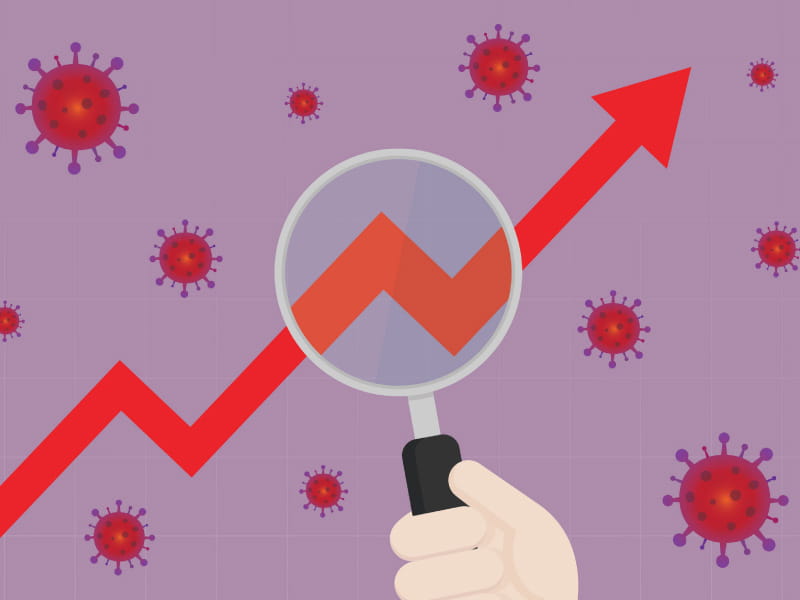Cardiovascular deaths saw steep rise in U.S. during first year of the COVID-19 pandemic
By American Heart Association News

The first year of the COVID-19 pandemic saw a steep rise in cardiovascular disease deaths in the U.S., with especially high mortality rates for Asian, Black and Hispanic people, according to a new statistical report from the American Heart Association.
Cardiovascular disease-related deaths jumped from 874,613 in 2019 to 928,741 in 2020, the largest single-year increase since 2015, according to the 2023 update to AHA's heart disease and stroke statistics, which was published Wednesday in Circulation. The number of deaths surpassed the previous high of 910,000 in 2003.
Cardiovascular disease includes heart disease, stroke, heart failure and hypertension, or high blood pressure. Heart disease remains the leading cause of death in the U.S. and globally. In 2020, COVID-19 also appeared among the leading causes of death in the U.S.
"What may be even more telling is that our age-adjusted mortality rate increased for the first time in many years and by a fairly substantial 4.6%," writing committee chair Dr. Connie W. Tsao said in a news release. Tsao is an assistant professor of medicine at Harvard Medical School and an attending staff cardiologist at Beth Israel Deaconess Medical Center in Boston.
"The age-adjusted mortality rate takes into consideration that the total population may have more older adults from one year to another, in which case you might expect higher rates of death among older people," she said. "So even though our total number of deaths have been slowly increasing over the past decade, we have seen a decline each year in our age-adjusted rates – until 2020."
The reversal was not surprising in light of the tremendous impact COVID-19 had on people of all ages, Tsao said, "especially before vaccines were available to slow the spread."
Asian, Black and Hispanic communities saw the largest increases in cardiovascular-related deaths, highlighting ongoing structural and societal disparities, the report found.
"People from communities of color were among those more highly impacted, especially early on, often due to a disproportionate burden of cardiovascular risk factors such as hypertension and obesity," AHA President Dr. Michelle A. Albert said in the release. She is the Walter A. Haas-Lucie Stern Endowed Chair in Cardiology, a professor of medicine at the University of California, San Francisco and admissions dean for UCSF Medical School.
The statistical update highlights the many ways COVID-19 impacts cardiovascular health, including its relationship to risk factors for heart disease and stroke. Factors such as obesity, diabetes and high blood pressure put people at higher risk for more severe COVID-19 illness.
"COVID-19 has both direct and indirect impacts on cardiovascular health," Albert said. "As we learned, the virus often attacks the body's circulatory system, causing new clotting and inflammation. We also know that many people who had new or existing heart disease and stroke symptoms were reluctant to seek medical care, particularly in the early days of the pandemic. This resulted in people needing more acute or urgent treatment for what may have been manageable chronic conditions. And, sadly, appears to have cost many their lives."
The report also highlights a variety of gender, race and ethnicity-related disparities that surfaced in the research. But a special commentary authored by members of the updated report's writing committee noted that data on some groups, such as LGBTQ people and those living in rural areas, are still lacking.
"We know that to address discrimination and disparities that impact health, we must better recognize and understand the unique experiences of individuals and populations," Tsao said.
This year's statistical update includes data showing global and regional trends in deaths related to different cardiovascular diagnoses and risk factors.
The data show that globally, ischemic heart disease, also known as coronary heart disease, and stroke are the top two causes of death linked to cardiovascular disease, with rates rising around the world over the past decade in all but two regions – North America and Europe/Central Asia. In North America, heart disease death rates have been falling in recent decades, from 28.2% of all deaths in 1990 to 18.7% in 2019. Stroke deaths fell from 7.3% of all deaths in 1990 to 6.4% in 2019.
In Europe and Central Asia, heart disease death rates fell from 27.2% of all deaths in 1990 to 24.4% in 2019, with stroke death rates falling from 15.1% to 12.5% during that time.
"As the U.S. prepares to celebrate the 60th annual Heart Month in February, it's critical that we recognize and redouble the lifesaving progress we've made in nearly a century of researching, advocating and educating, while continuing to identify and understand those barriers that still put certain people at increased risk for cardiovascular disease," Albert said.
If you have questions or comments about this American Heart Association News story, please email [email protected].





